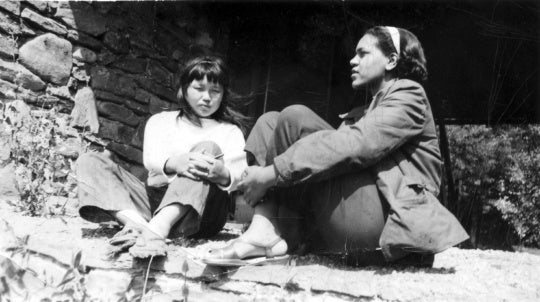
A person’s shoes tell a lot about them, where they might be going, what types of activities they’re engaged in, and sometimes even socioeconomic status. People live their lives in their shoes, so it’s worth taking a closer look at this ubiquitous piece of attire, something the exhibition “The Rise of Sneaker Culture” sets out to do. Midway through an international tour, the show is on view at the High Museum of Art through August 14.

“The Rise of Sneaker Culture” presents over 150 pairs of shoes, drawn from the archives of such manufacturers as Adidas, Converse, Puma, and Reebok; the collections of Toronto’s Bata Shoe Museum (where the exhibition originated), the online Kosow Sneaker Museum and Northampton Museums and Art Gallery in the UK; and private collectors. This is the first museum exhibition in the U.S. to examine the social and economic evolution of sneakers from the mid-19th century to today, and the variety of shoes along with the historical background about the invention of tennis shoes and the development of shoe marketing makes the exhibition a must-see.
Highlights range from an original well-worn Converse All-Star from 1917 to Kanye West’s Yeezy tennis shoe to a pair of gold slip-ons covered with spikes by designer Christian Louboutin. A pair of Nikes called Obama Force One, by artist Jimm Lasser, have an image of President Obama carved into the soles. The pair of Nike SB Dunks from 2005 designed with hip hop group De la Soul is a work of art; they feature a holographic print from the group’s 1989 album cover 3 Feet High and Rising. Shoes by such artists as Damien Hirst and Tom Sachs are also included.

The inundation of brand marketing means that many of us associate, for example, the black-and-white Adidas shell tops with three stripes with rap trio RUN-DMC, and a jumping man with an uplifted basketball with Chicago Bulls player Michael Jordan. The legacy of Jordan’s contributions to Nike stock, $4.2 billion for the Jordan Brand in 2014 alone, according to Forbes, threatens to outweigh his decades of outstanding athleticism. Fittingly, “Sneaker Culture” devotes an entire section of display space to some of the most memorable Jordan shoes.

While the show provides a fascinating overview of sneaker culture, there are some elements that warrant more in-depth examination. Exhibition materials mention the historical hyper-masculine nature of the sneaker market and the exclusion of women. An early women’s tennis shoe made by Dominion Rubber Company in 1925 looks like a lace-up high-heeled shoe, but the bottom is made of rubber. This practice of adding “feminine” design details to women’s athletic shoes persists today — pinks and pastels proliferate — and reinforces the gender binary. There are women who identify as “sneakerheads,” or collectors of limited edition sneakers, but they are not granted significance in the exhibition.
Another aspect in need of more scrutiny is the influence of hip hop artists and black athletes on sneaker economics. On many Saturday mornings, sneakerheads form lines at tennis shoe stores for the latest Nike release, especially the Air Jordans. Many of those sneakerheads then sell the shoes they bought at a local Finish Line or Foot Locker to other collectors. It is no surprise that Nike is making billions of dollars on shoe sales, but the economic impact of the sneaker craze is bigger than that and even inspired a segment on the Daily Show with Trevor Noah and “sneaker data expert” Josh Luber’s TED Talk “Why sneakers are a great investment.” In Luber’s talk, he states that people selling shoes in the sneaker resell market made $380 million in 2014. Skechers, Nike’s next closest competitor, made $209 million.

The most important point Luber makes is that the $1.2-billion sneaker resell market allows for people who, because of youth or socioeconomic status, cannot buy and sell on the NASDAQ to participate in an unregulated, democratized stock market. In a society where many young men of color are viewed with suspicion, having a coveted pair of shoes can be the difference between being bullied and having a place at the cool kids table—and they can making thousands of dollars selling shoes online. But there is an ugly side to all of this capitalistic materialism, and it was felt in 2012 in Grayson, Georgia, when 14-year-old Paul Sampleton was robbed and killed for his sneaker collection. In celebrating the increasing popularity of tennis shoes after the Industrial Revolution, the exhibition glosses over the sometimes lethal outcomes of the competitive sneaker market that thrives off of racism and reinforces the divide between the haves and the have-nots.

Still, “Sneaker Culture” is a much needed outlier for the High Museum, and the crowd on opening day was diverse in age and race, which is a welcome sight at the museum. The combination of history, utility, and novelty lend the exhibition a lot of appeal, and it is definitely worth the trip to see some cool kicks.
Organized by the American Federation of Arts, “The Rise of Sneaker Culture” made its U.S. debut at the Brooklyn Museum in 2015 and traveled to the Toledo Museum of Art. After its run at the High Museum [ending Aug. 14], it will appear at the Speed Art Museum in Louisville, Sept. 10-Nov. 27; the Oakland Museum of California, Jan. 8-Apr. 2, 2017; and the Art Gallery of Western Australia May 6-Sept. 4, 2017.
Kelundra Smith is a freelance arts journalist and editor. Her work has been published in the Atlanta Journal Constitution, Atlanta Magazine, Charleston Post & Courier, American Theatre Magazine, Dramatics magazine, Syracuse New Times, and on BroadwayWorld.com and ArtsATL.com. She has also done marketing and public relations consulting for nonprofit arts organizations, including Syracuse Stage, Alliance Theatre, Rialto Center for the Arts and Horizon Theatre Company. Follow her on Twitter @pieceofkay.




